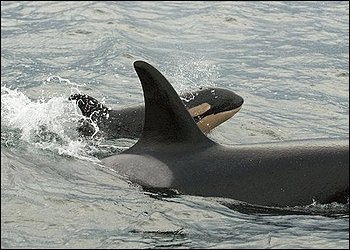forum
library
tutorial
contact

Save the Salmon -- and Us
by Carl SafinaLos Angeles Times, January 24, 2010
|
the film forum library tutorial contact |

|
Save the Salmon -- and Usby Carl SafinaLos Angeles Times, January 24, 2010 |
Recently, a photograph made its way to me on the Internet: In a surging Alaskan stream, a grizzly bear stands with a salmon in its jaws, and in the shallows, a wolf -- keeping its distance -- also hoists a thrashing salmon. Your eye goes to the bear, then the wolf. But the salmon convened the meeting. Without the salmon, you'd see only water.
When salmon return from the sea, their bodies are the ocean made flesh. Their tails propel ocean nutrients upstream and into forests, rivers and range lands, where they benefit hundreds of other species. Everything else in the photograph -- trees, bushes, all the animals and plants in the forest and the water -- contains ocean nutrients from salmon.
And now add orcas to the web of life fed by salmon. New research tells us that, before salmon hit the flowing streams, they are by far the most important food for resident killer whales along the Pacific Coast.
These killer whales, like wild salmon, are endangered. Of course the problems are connected: The fewer salmon, the fewer orcas.
Hope flared in early 2009, when the Obama administration's blueprint for Sacramento River salmon affirmed this salmon-orca connection and promised to put policies in place that would result in more wild salmon. It seemed like a strong first step in protecting West Coast salmon stocks.
But then two months ago, in a swift trick no one saw coming, the Obama administration embraced the Bush administration's failed salmon plan for an even more important watershed, the Columbia/Snake River system. The Columbia and its tributaries formerly produced more salmon than anywhere else on Earth, but the once-mighty rivers now have 13 salmon stocks in danger of extinction.
Federal scientists say this decline of Columbia/Snake salmon is the largest single change to the resident killer whale's food supplies. Yet the administration's Columbia plan seems to ignore that connection. While the Sacramento plan stated clearly that increasing wild salmon stocks is important -- for the whales and for people alike -- the Columbia plan contends that hatchery salmon will be enough to compensate for further losses.
The Obama plan adopts the Bush plan's legal and scientific analysis unchanged and in its entirety. It makes a few small tweaks elsewhere, but does not require anything that would actually save fish. The most "major" change calls for additional actions to be studied -- though not necessarily enacted -- if listed species continue to decline precipitously.
The fundamental problem with the plan is that its goal seems to be to maintain endangered salmon in an endangered state rather than revitalizing them. The administration appears unmotivated to restore salmon abundance and their role in the ecology and economy. Here's what gives the administration's game away: The one salmon species that is already at levels low enough to trigger additional action in the new plan has been exempted from the new triggers.
 Jane Lubchenco, the administration's point person for oceans and salmon, insists that "the actions in the plan will prevent further declines." But keeping salmon in a coma and on life support does not heal them, nor help the other species, including people, that depend on them. The likeliest outcome of a salmon strategy based on just avoiding extinction will be extinction -- and not only of salmon.
Jane Lubchenco, the administration's point person for oceans and salmon, insists that "the actions in the plan will prevent further declines." But keeping salmon in a coma and on life support does not heal them, nor help the other species, including people, that depend on them. The likeliest outcome of a salmon strategy based on just avoiding extinction will be extinction -- and not only of salmon.
A wiser strategy would focus on restoring salmon's workhorse role for people and ecosystems. In the Columbia Basin, it would include removing four federal dams on the Snake River, which would open 3,000 miles of healthy streams above the present dams for three salmon species and double the spawning habitat for a fourth.
The Obama administration missed its first chance to hit the "reset" button on Pacific Northwest salmon strategy. But it's not too late to reconsider. It should embrace salmon abundance as the beating heart of the Pacific Northwest -- the flow of energy that connects and sustains people, fishing towns, bears, wolves, orcas, forests and the rivers and seas we all love and use.
There's another photograph I saw recently. Taken just two months ago where Puget Sound meets the Pacific, it shows a new orca calf emerging from the water atop its mother's back. The scientists from the Center for Whale Research who track orcas named her Star, hoping she will guide another seemingly intelligent mammal -- us -- to restore the salmon abundance she will need to become a mother herself 13 years from now. May she inspire the Obama administration to think again.
Related Pages:
Is Washington's Orca Baby Boom a Fluke? by George Tibbits, Washington Post, 1/9/10
Salmon Support 137 Other Species by Ed Hunt, Environment News Service, 7/6/00
learn more on topics covered in the film
see the video
read the script
learn the songs
discussion forum
